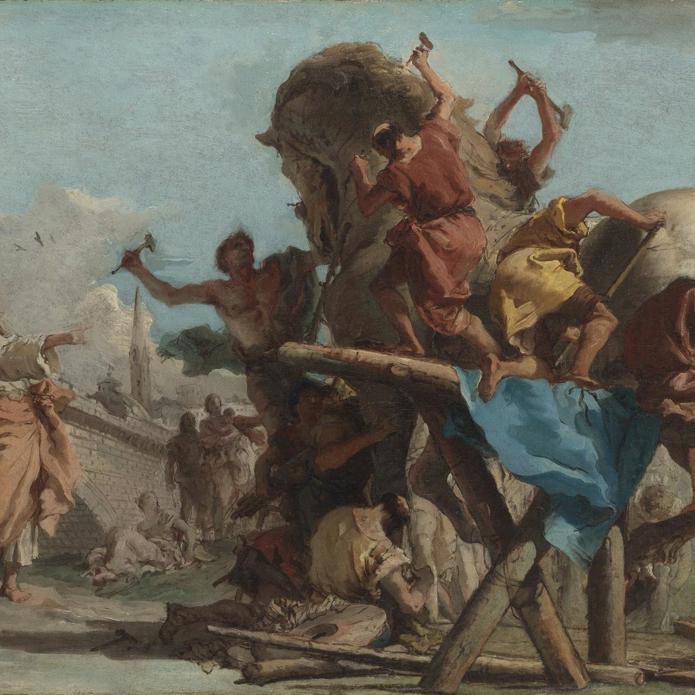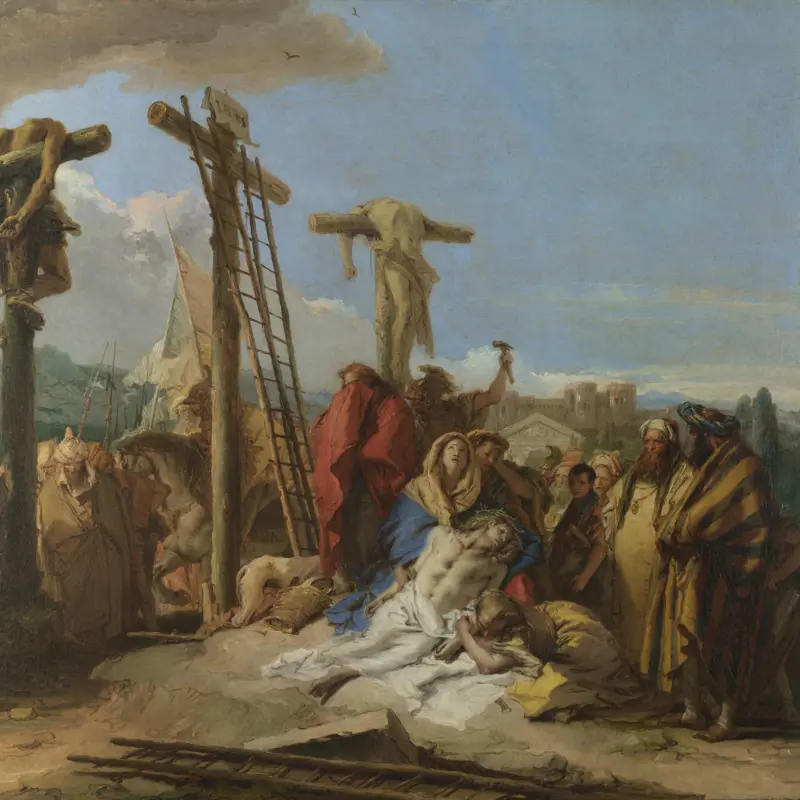Giovanni Domenico Tiepolo, 'The Procession of the Trojan Horse into Troy', about 1760
About the work
Overview
This painting shows an episode from the mythological Trojan War, as described by the Roman poet Virgil in the Aeneid. The Trojans rejoice as they pull a large wooden horse into their city, believing it to be a gift from the gods; it actually conceals a band of Greek soldiers. In the background, Cassandra, daughter of the King of Troy, is being arrested for having prophesied disaster if the horse entered the city. She turned out to be right: once inside, the Greeks took control of Troy.
The feverish activity of the crowd and the horse’s muscular build and looming stature convey the story’s epic nature. The high walls and the sharply receding space lead our eye towards the city of Troy in the distance, which Tiepolo based on ancient buildings and fortifications in Rome.
Key facts
Details
- Full title
- The Procession of the Trojan Horse into Troy
- Artist
- Giovanni Domenico Tiepolo
- Artist dates
- 1727 - 1804
- Part of the series
- Two Sketches depicting the Trojan Horse
- Date made
- About 1760
- Medium and support
- Oil on canvas
- Dimensions
- 38.8 × 66.7 cm
- Acquisition credit
- Bought, 1918
- Inventory number
- NG3319
- Location
- Not on display
- Collection
- Main Collection
Provenance
Additional information
Text extracted from the ‘Provenance’ section of the catalogue entry in Michael Levey, ‘National Gallery Catalogues: The Seventeenth and Eighteenth Century Italian Schools’, London 1986; for further information, see the full catalogue entry.
Exhibition history
-
2020Tiepolo - Venice in the NorthSinebrychoff Art Museum17 September 2020 - 10 January 2021
Bibliography
-
1956Levey, Michael, National Gallery Catalogues: The Eighteenth Century Italian Schools, London 1956
-
1986Levey, Michael, National Gallery Catalogues: The Seventeenth and Eighteenth Century Italian Schools, London 1986
-
2001
C. Baker and T. Henry, The National Gallery: Complete Illustrated Catalogue, London 2001
About this record
If you know more about this work or have spotted an error, please contact us. Please note that exhibition histories are listed from 2009 onwards. Bibliographies may not be complete; more comprehensive information is available in the National Gallery Library.
Images
About the series: Two Sketches depicting the Trojan Horse

Overview
The Building of the Trojan Horse and The Procession of the Trojan Horse are part of a series illustrating the fall of Troy, an ancient city on the coast of Turkey that was besieged by Greek armies for ten years. The Trojan War was one of the most important events in Greek mythology.
According to Virgil’s Aeneid (Book 2), the Greeks built a giant wooden horse in which they could hide their men, and left it outside the impregnable walls of Troy. The Trojans, believing it to be a gift, wheeled it inside the city. Under the cover of darkness, the Greek soldiers climbed out of the horse and took Troy.
Painted in around 1760, these scenes were probably intended as preparatory designs for larger oil paintings. Domenico’s monumental The Building of the Trojan Horse is in the Wadsworth Atheneum, in the United States, but the whereabouts of the other large canvasses is not known.





